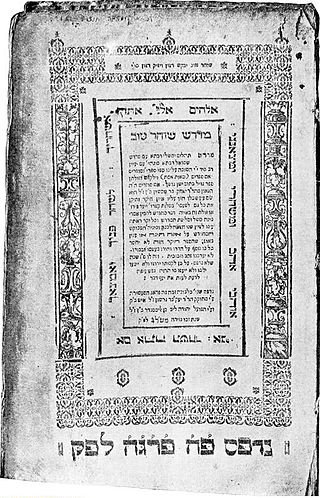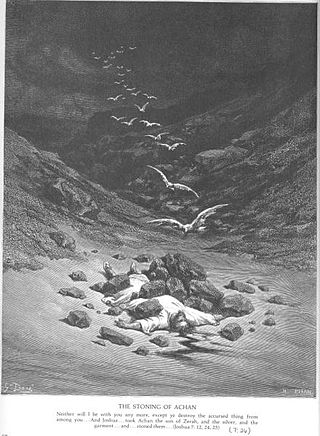Related Research Articles

In Judaism, the concept of the Jews as the chosen people is the belief that the Jews, via descent from the ancient Israelites, are the chosen people, i.e. selected to be in a covenant with God. The idea of the Israelites being chosen by God is found most directly in the Book of Deuteronomy as the verb baḥar (בָּחַר), and is alluded to elsewhere in the Hebrew Bible using other terms such as "holy people". Much is written about these topics in rabbinic literature. The three largest Jewish denominations—Orthodox Judaism, Conservative Judaism and Reform Judaism—maintain the belief that the Jews have been chosen by God for a purpose. Sometimes this choice is seen as charging the Jewish people with a specific mission—to be a light unto the nations, and to exemplify the covenant with God as described in the Torah.

Deuteronomy is the fifth book of the Torah, where it is called Devarim and the fifth book of the Christian Old Testament.
Halakha, also transliterated as halacha, halakhah, and halocho, is the collective body of Jewish religious laws that are derived from the Written and Oral Torah. Halakha is based on biblical commandments (mitzvot), subsequent Talmudic and rabbinic laws, and the customs and traditions which were compiled in the many books such as the Shulchan Aruch. Halakha is often translated as "Jewish law", although a more literal translation of it might be "the way to behave" or "the way of walking". The word is derived from the root which means "to behave". Halakha not only guides religious practices and beliefs, it also guides numerous aspects of day-to-day life.

Judaism is the oldest Abrahamic religion. Judaism is monotheistic, and widely an ethnic religion. It comprises the collective spiritual, cultural, and legal traditions of the Jewish people, having originated as an organized religion in the Middle East during the Bronze Age. Contemporary Judaism evolved from Yahwism, the cultic religious movement of ancient Israel and Judah, around the 6th/5th century BCE, and is thus considered to be one of the oldest monotheistic religions. Religious Jews regard Judaism as their means of observing the Mosaic covenant, which was established between God and the Israelites, their ancestors. Jewish religious doctrine encompasses a wide body of texts, practices, theological positions, and forms of organization.

Midrash is expansive Jewish Biblical exegesis using a rabbinic mode of interpretation prominent in the Talmud. The word itself means "textual interpretation", "study", or "exegesis", derived from the root verb darash (דָּרַשׁ), which means "resort to, seek, seek with care, enquire, require", forms of which appear frequently in the Hebrew Bible.

The Torah is the compilation of the first five books of the Hebrew Bible, namely the books of Genesis, Exodus, Leviticus, Numbers and Deuteronomy. The Torah is known as the Pentateuch or the Five Books of Moses by Christians. It is also known as the Written Torah in Jewish tradition. If meant for liturgic purposes, it takes the form of a Torah scroll. If in bound book form, it is called Chumash, and is usually printed with the rabbinic commentaries.

The documentary hypothesis (DH) is one of the models used by biblical scholars to explain the origins and composition of the Torah. A version of the documentary hypothesis, frequently identified with the German scholar Julius Wellhausen, was almost universally accepted for most of the 20th century. It posited that the Pentateuch is a compilation of four originally independent documents: the Jahwist (J), Elohist (E), Deuteronomist (D), and Priestly (P) sources. The first of these, J, was dated to the Solomonic period. E was dated somewhat later, in the 9th century BCE, and D was dated just before the reign of King Josiah, in the 7th or 8th century BCE. Finally, P was generally dated to the time of Ezra in the 5th century BCE. The sources would have been joined at various points in time by a series of editors or "redactors".

Hermeneutics is the theory and methodology of interpretation, especially the interpretation of biblical texts, wisdom literature, and philosophical texts. As necessary, hermeneutics may include the art of understanding and communication.

Torah study is the study of the Torah, Hebrew Bible, Talmud, responsa, rabbinic literature, and similar works, all of which are Judaism's religious texts. According to Rabbinic Judaism, the study is done for the purpose of the mitzvah ("commandment") of Torah study itself.

Midrash halakha was the ancient Judaic rabbinic method of Torah study that expounded upon the traditionally received 613 Mitzvot (commandments) by identifying their sources in the Hebrew Bible, and by interpreting these passages as proofs of the laws' authenticity.

Exegesis is a critical explanation or interpretation of a text. The term is traditionally applied to the interpretation of Biblical works. In modern usage, exegesis can involve critical interpretations of virtually any text, including not just religious texts but also philosophy, literature, or virtually any other genre of writing. The phrase Biblical exegesis can be used to distinguish studies of the Bible from other critical textual explanations.
According to Rabbinic Judaism, the Oral Torah or Oral Law are statutes and legal interpretations that were not recorded in the Five Books of Moses, the Written Torah, and which are regarded by Orthodox Jews as prescriptive and given at the same time. This holistic Jewish code of conduct encompasses a wide swathe of rituals, worship practices, God–man and interpersonal relationships, from dietary laws to Sabbath and festival observance to marital relations, agricultural practices, and civil claims and damages.
Biblical hermeneutics is the study of the principles of interpretation concerning the books of the Bible. It is part of the broader field of hermeneutics, which involves the study of principles of interpretation, both theory and methodology, for all forms of communication, nonverbal and verbal.
This is a list of books by Jacob Neusner. Articles, reviews, etc. are not included here.
Pardes (פרד"ס) is a Kabbalistic theory of Biblical exegesis first advanced by Moses de León, adapting the popular "fourfold" method of medieval Christianity. The term, sometimes also rendered PaRDeS, means "orchard" when taken literally, but is used in this context as a Hebrew acronym formed from the initials of the following four approaches:
Bernard Malcolm Levinson serves as Professor of Classical and Near Eastern Studies and of Law at the University of Minnesota, where he holds the Berman Family Chair in Jewish Studies and Hebrew Bible. He is the author of Deuteronomy and the Hermeneutics of Legal Innovation, "The Right Chorale": Studies in Biblical Law and Interpretation, and Legal Revision and Religious Renewal in Ancient Israel; and is the co-editor of The Pentateuch as Torah: New Models for Understanding Its Promulgation and Acceptance. He has published extensively on biblical and ancient Near Eastern law and on the reception of biblical literature in the Second Temple period. His research interests extend to early modern intellectual history, constitutional theory, the history of interpretation, and literary approaches to biblical studies.

Herem or cherem, as used in the Tanakh, means something given over to the Lord, or under a ban, and sometimes refers to things or persons to be utterly destroyed. The term has been explained in different and sometimes conflicting ways by different scholars. It has been defined as "a mode of secluding, and rendering harmless, anything imperilling the religious life of the nation", or "the total destruction of the enemy and his goods at the conclusion of a campaign", or "uncompromising consecration of property and dedication of the property to God without possibility of recall or redemption". It is translated into Latin as devotio, a word used for human sacrifice, and into Greek as anathema, which was a sacrifice to the gods.
Hermeneutics is a theory of text interpretation.

Brevitas et Facilitas means "brevity and simplicity" in English, the hermeneutical method of John Calvin. Especially he used this method in the dedication in the Commentary on Romans. Calvin presented his own distinctive method of the hermeneutics of Scripture in his Commentary on the Epistle of Paul, the Apostle, to the Romans. It is called the ideal of brevitas et facilitas. Calvin was not satisfied with both Malanchthon's loci method and Bucer's prolixity commentary. He took a via media approach. Calvin's method was influenced by the rhetoric of Aristotle, Cicero, Quintilian and Chrysostom. Calvin, however, confirmed that his own principle came from Scripture itself. Calvin showed that the clarity of Scripture was related to the ideal of brevitas et facilitas. According to John Bolt this means the brevitas et dilucidatio of Thomas Aquinas.
The composition of the Torah was a process that involved multiple authors over an extended period of time. While Jewish tradition holds that all five books were originally written by Moses sometime in the 2nd millennium BCE, leading scholars have rejected Mosaic authorship since the 17th century.
References
- ↑ Jeanrond, Werner G. (1994). Theological hermeneutics: development and significance. SCM Press. ISBN 978-0-334-01624-3. Archived from the original on 2022-02-22. Retrieved 2022-02-22.
- ↑ Theological Hermeneutics, p. 86, Alexander S. Jensen, SCM 2007. ISBN 978-0-334-02901-4
- ↑ (1999)Dictionary of Biblical Interpretation, D.E. Klemm, "Hermeneutics", 497-502
- ↑ "Dennis Whalen, Lutheran Understanding of Law and Gospel" (PDF). Archived (PDF) from the original on 2020-09-22. Retrieved 2017-10-06.
- ↑ "Ahn, Myung Jun, The Ideal of Brevitas et Facilitas: the theological hermeneutics of John Calvin, Skrif en Kerk Volume 20 Issue 2 (1999)" (PDF). Archived (PDF) from the original on 2017-10-06. Retrieved 2017-10-06.
- ↑ "Ahn, Myung Jun, Brevitas et facilitas : a study of a vital aspect in the theological hermeneutics of John Calvin (Ph.D. Diss., University of Pretoria, 1998)". hdl:2263/26944. Archived from the original on 2017-10-06. Retrieved 2017-10-06.
- ↑ A. C. Thiselton (1988). "Hermeneutics". In Ferguson, Sinclair B.; Wright, David F.; Packer, J. I. (eds.). New Dictionary of Theology. Downers Grove, Ill.: InterVarsity Press. pp. 293–297. ISBN 0-8308-1400-0.
- ↑ Hartill, J E 1960. Principles of Biblical Hermeneutics. Grand Rapids: Zondervan.
- ↑ Kwok Pui-lan (2005). Postcolonial Imagination and Feminist Theology. Louisville, KY: Westminster John Knox Press. ISBN 978-0-664-22883-5. Archived from the original on 2021-11-11. Retrieved 2022-02-22.
- ↑ Sugirtharajah, R. S. (2001). The Bible and the Third World: Precolonial, Colonial, and Postcolonial Encounters. Cambridge, England: Cambridge University Press (published 2009). doi:10.1017/CBO9780511612619. ISBN 978-0-51161-261-9.
- ↑ "Archived copy" (PDF). Archived (PDF) from the original on 2019-10-21. Retrieved 2019-10-28.
{{cite web}}: CS1 maint: archived copy as title (link) - ↑ "CfP: Biblical Scholarship as a Modern Jewish Hermeneutic (special issue of Zeramim: An Online Journal of Applied Jewish Thought, III:3) | H-Judaic | H-Net". networks.h-net.org. Archived from the original on 2019-10-21. Retrieved 2019-10-28.
- ↑ "A Biblical Challenge: Can an Academic Approach Aimed at 'Best Explanation' of the Biblical Text Be Imported Into the Synagogue-Sermon World of 'Interpretation?' - Richard L. Claman". Archived from the original on 2020-07-14. Retrieved 2020-05-17.
- ↑ "Contemporary Jewish Theology in Light of Divergent Biblical Views on Revelation's Content - David Frankel". Archived from the original on 2020-07-14. Retrieved 2020-05-17.
- ↑ "Male Homosexual Intercourse Is Prohibited - In One Part of the Torah - TheTorah.com". www.thetorah.com. Archived from the original on 2019-10-21. Retrieved 2019-10-28.